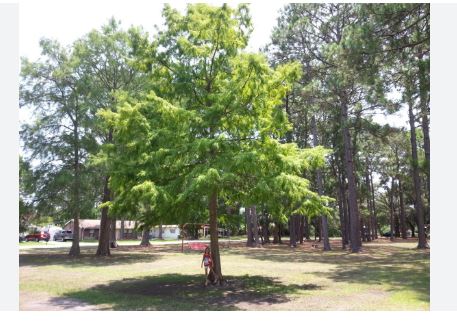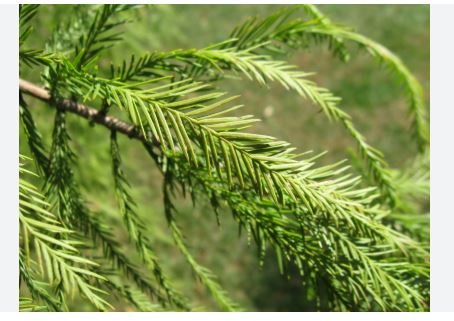
The Montezuma Cypress (Taxodium mucronatum), Mexico’s national tree, is a majestic conifer renowned for its towering stature, cultural significance, and adaptability to diverse environments. Often semi-evergreen or deciduous, this tree thrives in wetlands and uplands alike, with its iconic presence in Mexican landscapes symbolizing resilience and heritage. Its massive trunks, soft foliage, and ecological contributions make it a cherished species for ornamental planting, restoration projects, and historical sites. In this detailed guide, we explore the botanical classification, origin, identifying characteristics, habitat, distribution, USDA hardiness zones, uses, and fascinating facts about the Montezuma Cypress.
Botanical Classification, Origin and Native Area
The Montezuma Cypress, scientifically named Taxodium mucronatum, belongs to the Cupressaceae family, which includes cypresses, junipers, and cedars. It is classified within the genus Taxodium, alongside the Bald Cypress (Taxodium distichum) and Pond Cypress (Taxodium ascendens). The species name mucronatum, meaning “pointed” in Latin, refers to the sharp tips of its needle-like leaves.
As a gymnosperm, it produces cones rather than flowers, and its semi-evergreen to deciduous nature (depending on climate) distinguishes it from most conifers. Previously considered a variety of the Bald Cypress, it is now recognized as a distinct species based on genetic and morphological differences. Its taxonomic relatives reflect its adaptation to wetland and temperate environments.
The Montezuma Cypress is native to Mexico, Central America, and parts of the southern United States, with its primary range spanning from northeastern Mexico (Tamaulipas) to southern Guatemala and Belize. It is particularly associated with the highlands and river valleys of Mexico, where it has been revered for centuries.
Indigenous cultures, such as the Aztecs, planted it near water sources and sacred sites, and its wood was used for construction and carvings. The tree’s most famous specimen, the Árbol del Tule in Oaxaca, is believed to be over 2,000 years old, showcasing its historical and cultural significance. Fossil records indicate that Taxodium species were widespread across North America millions of years ago, with the Montezuma Cypress evolving to thrive in Mesoamerica’s diverse climates.
Identifying Characteristics

The Montezuma Cypress is a large conifer, typically growing 50–130 feet tall with a spread of 30–50 feet, though exceptional specimens can exceed 150 feet. Its trunk is often massive, with diameters up to 50 feet in ancient trees, and features a buttressed base in wet conditions. The bark is reddish-brown to gray, fibrous, and peels in thin strips.
The soft, needle-like leaves, 0.5–1 inch long, are bright green, arranged in feather-like sprays, and turn bronze before shedding in dry or cold seasons (deciduous in cooler climates, semi-evergreen in warmer ones). The tree produces small, woody cones (0.5–1 inch), spherical and green when young, maturing to brown with 8–12 scales. Unlike the Bald Cypress, it rarely forms prominent “knees” (pneumatophores), and its broad, spreading crown creates a majestic silhouette.
Habitat
The Montezuma Cypress thrives in a variety of habitats, from wetlands to uplands, including riverbanks, floodplains, marshes, and seasonal swamps. It is highly flood-tolerant, with roots adapted to saturated, oxygen-poor soils, but also grows well in drier, well-drained sites. It prefers acidic to neutral soils (pH 5.0–7.0), typically loamy or silty, and requires full sun (6+ hours daily) for optimal growth.
In its native range, it often grows near springs, rivers, or cenotes, contributing to water filtration and soil stabilization. In cultivation, it adapts to urban and suburban landscapes, rain gardens, and ornamental settings, provided drainage is adequate in non-wetland sites to prevent root rot. Its drought tolerance once established enhances its versatility.
Distribution
The Montezuma Cypress is naturally distributed across Mexico, from the Rio Grande Valley in Texas to southern Guatemala and Belize, with significant populations in the Sierra Madre Oriental, Oaxaca, and Chiapas. It is most abundant along rivers like the Pánuco and in highland valleys up to 7,000 feet elevation. In the United States, it occurs marginally in southern Texas, particularly along the Rio Grande.
Due to its ornamental and cultural value, it has been planted in temperate and subtropical regions worldwide, including the southwestern United States, Central America, and parts of South America, Europe, and Australia. It is not invasive but can naturalize in suitable wetland habitats. Conservation efforts focus on protecting ancient specimens and native stands, threatened by urban expansion and climate change.
USDA Hardiness Zones
The Montezuma Cypress thrives in USDA Hardiness Zones 8–11, tolerating minimum temperatures from 10°F to 40°F (-12°C to 4°C). It is best suited to warm, temperate to subtropical climates with hot summers and mild winters, though it can withstand brief cold snaps.
In Zone 8, young trees may require protection from frost, while in Zones 10–11, they flourish with minimal care. Its flood and drought tolerance, once established, makes it suitable for diverse environments, from humid wetlands to arid uplands, though it may struggle in consistently cold or high-altitude regions.
Uses
The Montezuma Cypress is a versatile tree with significant cultural, ecological, and ornamental applications. In landscaping, its towering stature, soft foliage, and bronze fall color (in deciduous regions) make it a striking specimen tree, shade provider, or focal point in parks, estates, and urban settings. It is ideal for rain gardens and wetland restoration due to its flood tolerance.
Ecologically, it stabilizes soil, filters water, and provides habitat for wildlife, including birds, amphibians, and fish in riparian ecosystems. Its durable, rot-resistant wood is used for construction, furniture, and crafts, though sustainable harvesting is emphasized due to the tree’s cultural and ecological importance. In Mexico, it is planted near water sources and historical sites, symbolizing life and continuity.
The tree’s resin and foliage are used in traditional medicine for their antiseptic properties, and its shade supports community gatherings in rural areas. In urban environments, it mitigates stormwater runoff and enhances air quality, thriving in sustainable designs. Culturally, it is a national emblem, revered in Mexican folklore and history.
Fun Facts
The Montezuma Cypress is steeped in captivating facts that highlight its extraordinary legacy. The Árbol del Tule in Oaxaca, Mexico, is considered the world’s largest single-trunk tree by diameter (over 46 feet), with debates over whether it is one tree or multiple fused trunks, and is estimated to be 2,000–3,000 years old.
Unlike its relative, the Bald Cypress, it rarely forms “knees,” making it less intrusive in cultivated landscapes. The tree was sacred to the Aztecs, who planted it near temples and springs, associating it with water deities. Its wood was used to craft the iconic Mexican “alebrijes” (colorful folk art sculptures), showcasing its cultural versatility. In warmer climates, it remains semi-evergreen, shedding needles only during drought, a unique adaptation among Taxodium species.
The Montezuma Cypress can grow in standing water for months, yet its drought tolerance allows it to thrive in Mexico’s arid highlands. Additionally, its massive size and longevity have inspired legends, with some trees believed to house spirits or mark ancient trade routes, cementing its place in Mesoamerican heritage.
Cultivation of Montezuma Cypress (Taxodium mucronatum)
Cultivating the Montezuma Cypress (Taxodium mucronatum), Mexico’s national tree and a majestic semi-evergreen to deciduous conifer, is a rewarding endeavor for gardeners, landscapers, and conservationists seeking a resilient, culturally significant tree. Native to Mexico and Central America, this species is prized for its towering stature, soft foliage, and adaptability to both wet and dry conditions, making it ideal for ornamental landscapes, wetland restoration, or urban plantings. While relatively low-maintenance, proper care ensures healthy growth and longevity, particularly in managing its large size and environmental needs.
- Climate Suitability: Montezuma Cypress thrives in USDA Hardiness Zones 8–11, tolerating minimum temperatures from 10°F to 40°F (-12°C to 4°C). It prefers warm, temperate to subtropical climates with hot summers and mild winters but can withstand brief cold snaps. In Zone 8, protect young trees from frost to prevent foliage or root damage.
- Site Selection: Choose a location with full sun exposure, receiving at least 6–8 hours of direct sunlight daily, to promote robust growth and vibrant foliage. Ensure the site accommodates the tree’s mature size (50–130 feet tall, 30–50 feet wide) and is suitable for wet or dry conditions, avoiding areas prone to prolonged freezing.
- Soil Requirements: Plant in acidic to neutral soil (pH 5.0–7.0), such as loamy, silty, or sandy types. Montezuma Cypress is highly adaptable, thriving in saturated wetland soils or well-drained upland soils. In non-wetland settings, ensure good drainage to prevent root rot, and amend poor soils with organic matter (e.g., compost) for improved fertility.
- Planting Time: The optimal planting seasons are early spring or fall, allowing roots to establish before extreme heat or cold. Dig a hole twice as wide and as deep as the root ball, positioning the root collar at or slightly above ground level. Backfill with native soil, tamp gently, and water deeply to settle the roots and eliminate air pockets.
- Watering Needs: Water young trees deeply and regularly (1–2 times weekly) for the first 1–2 years to establish a strong root system, keeping soil consistently moist. The tree is flood-tolerant, enduring months of standing water, and drought-tolerant once established. In upland plantings, provide supplemental watering during extended dry periods to maintain health.
- Mulching: Apply a 2–4 inch layer of organic mulch (e.g., wood chips, pine bark) around the base, extending to the drip line but keeping it 2 inches from the trunk. Mulch conserves moisture, regulates soil temperature, and suppresses weeds, supporting young trees in both wetland and upland sites. Replenish mulch annually to maintain effectiveness.
- Fertilization: Fertilize young trees sparingly in early spring with a balanced, slow-release fertilizer (e.g., 10-10-10) to encourage healthy growth. Apply at half the recommended rate to avoid over-fertilization, which can lead to weak growth. Mature trees typically require no supplemental feeding in fertile or wetland soils, as they are adapted to nutrient-poor environments.
- Pruning: Prune minimally to maintain shape or remove dead, damaged, or crossing branches, ideally in late winter or early spring before new growth begins. Use clean, sharp shears for precise cuts. The tree’s natural conical to spreading crown requires little shaping, but light pruning can enhance structure in urban or ornamental settings.
- Pest and Disease Management: Monitor for pests such as bagworms, spider mites, or cypress moths, treating infestations with insecticidal soap or neem oil. Montezuma Cypress is relatively disease-resistant but may develop root rot in poorly drained, non-wetland soils or fungal issues in overly humid conditions. Ensure proper drainage and avoid overhead watering to minimize disease risk.
- Spacing: Space trees 20–30 feet apart to accommodate their mature spread (30–50 feet), ensuring adequate sunlight and air circulation to prevent fungal issues. For group plantings or restoration projects, closer spacing (15–20 feet) can mimic natural stands. Consider their towering height (50–130 feet) when planting near structures or power lines.
- Wind Protection: Young Montezuma Cypresses, with shallow roots, are susceptible to windthrow in exposed areas. Stake newly planted trees for the first 1–2 years using flexible ties to allow slight trunk movement, which strengthens roots. Remove stakes once established to promote independent growth and long-term stability.
- Winter Care: In Zone 8, protect young trees from frost damage by mulching heavily around the base to insulate roots and watering adequately before freeze-up. In colder microclimates, wrap trunks with burlap to shield against frost cracking. Mature trees are frost-tolerant in their hardiness range and require minimal winter care, even in semi-deciduous regions.
- Long-Term Growth: Montezuma Cypresses grow moderately fast (1–2 feet per year) in optimal conditions, reaching 50–130 feet at maturity, with some living over 2,000 years. Their massive trunks, soft foliage, and bronze fall color (in deciduous regions) make them ideal for wetland restoration, shade, or monumental specimen planting. Regular monitoring ensures ecological benefits and structural health, especially in urban or historical landscapes.